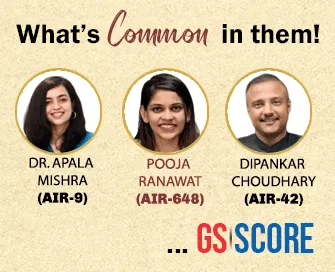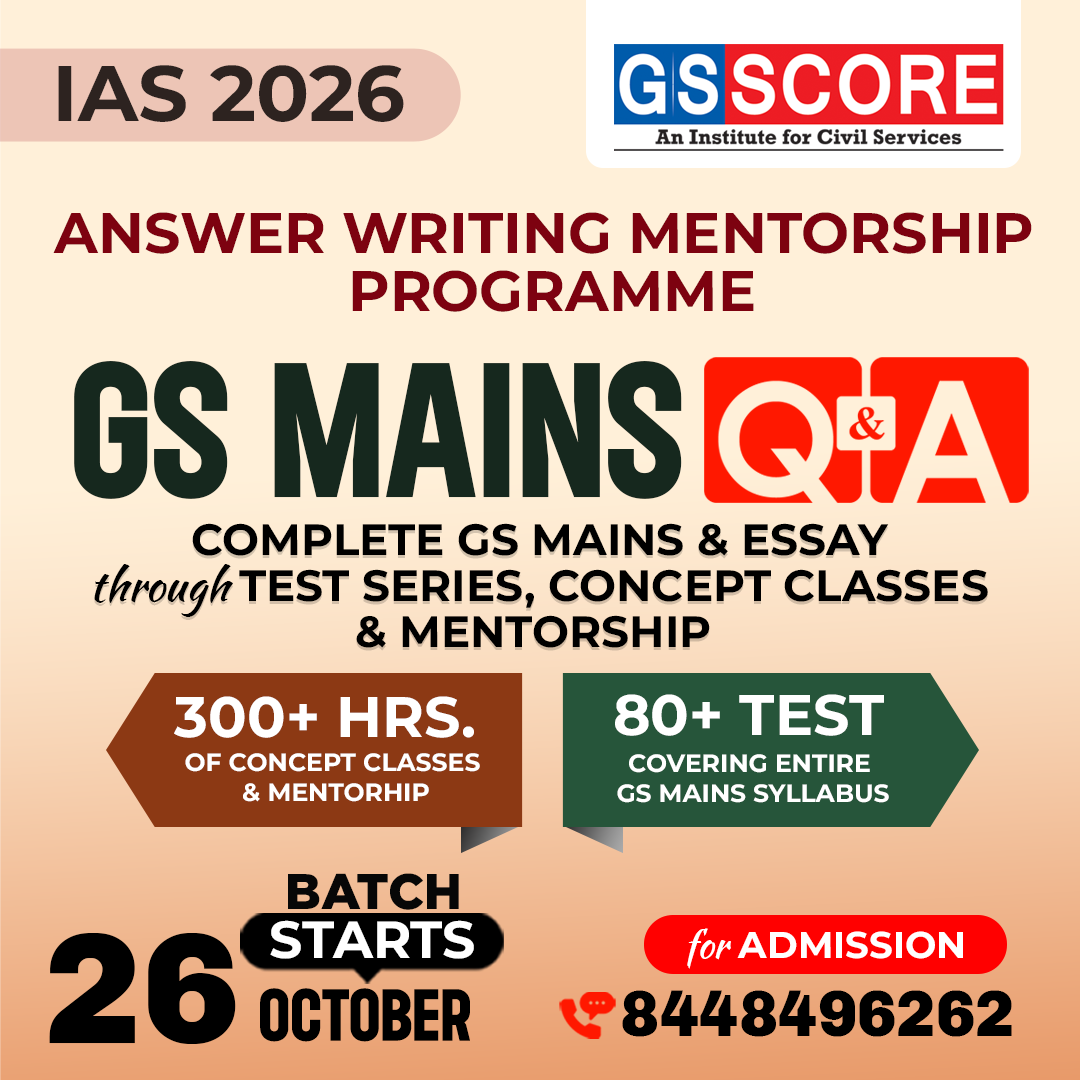

.jpg)
Instruction:
- Attempt One question out of the given two.
- The test carries 15 marks.
- Write Your answer in 150 words.
- Any page left blank in the answer-book must be crossed out clearly.
- Evaluated Copy will be re-uploaded on the same thread after 2 days of uploading the copy.
- Discussion of the question and one to one answer improvement session of evaluated copies will be conducted through Google Meet with concerned faculty. You will be informed via mail or SMS for the discussion.
Question #1. The accurate picture of the complex socio-cultural milieu of Peninsular India is presented in the early Sangam literature. Elucidate.
Question #2. The Sun Temple at Konark has all the features of the Orissa temple architecture style. Give an example
(Examiner will pay special attention to the candidate's grasp of his/her material, its relevance to the subject chosen, and to his/ her ability to think constructively and to present his/her ideas concisely, logically and effectively).
STEPS & INSTRUCTIONS for uploading the answers
Step 1 - The Question for the day is provided below these instructions. It will be available at 7:00 AM.
Step 2 - Uploading of Answers : Write the answer in A4 Sheet leaving proper margins for comments and feedback and upload the PDF in MY ACCOUNT section. Click on the option of SUBMIT COPY to upload the PDF.
Step 3 - Deadline for Uploading Answers: The students shall upload their answers by 7:00 PM in the evening same day. The first 50 copies will be evaluated.
Step 4 - Feedback : Mentors will give their feedback for the answers uploaded. For more personalised feedback, join our telegram channel by clicking on the link https://t.me/mains_answer_writing_cse . A one-to-one session will be conducted with the faculty after copy evaluation in 72 Hrs.
Model Answer
Question #1. The accurate picture of the complex socio-cultural milieu of Peninsular India is presented in the early Sangam literature. Elucidate.
Approach
- The question focuses on a pillar of Socio-cultural milieu of Peninsular India that is presented in the early Sangam literature.
- The perspective of the question is simple and straightforward.
- Introduction (Summary of key demand of the question, along with necessary facts).
- Conclusion by summing up the gist of the answer.
Hints:
Sangam literature was composed from 100 AD to 250 AD by Tamil poets belonging to the Chera, Chola and Pandya kingdoms.The works of the third Sangam give information about polity, religion, economy and society of the period.
Socio-cultural milieu of Peninsular India is presented in the early Sangam literature:
- These were written by bards in praise of kings/chiefs. Though full of exaggeration they do enlighten about the culture, social norms, politics and economic life of the period. These works do not fit in western notion of history as narration of political events but they covered many areas other than political narration.
- In Manimekhalai, a vivid description of the city of Puhar (Kaveripattanam) is given. On the basis of which extent of trade and economy can be constructed. They had mainly dealt with the culture of the court but life of common masses was also dealt with.
- The concept of tinai, according to which the landscape was divided into five regions based on ecological niche can be understood and activities associated with these regions like hunting and gathering in hilly region, pastoralism in semi-arid region, agriculture in plains can be dissected.
- Sangam literature also presents the evolution of religion and Bhakti in South India. The deities associated with different regions were included into the pantheon of Hinduism. The spread of Sanskritic culture and spread of Puranas linking local religion with broader Hinduism can also be discerned from these texts.
These texts also presented a picture of urban life and also the polity prevalent at that time. So these texts are important sources if dealt properly by reading between the lines.
Question #2. The Sun Temple at Konark has all the features of the Orissa temple architecture style. Give an example
Approach
- Briefly Introduce Konark Sun Temple (40 words)
- Explain how it represents Orissa temple architecture style(170 words)
- Conclude (40 words)
Hints:
Sun Temple of Konark, built in the middle of 13th century, is a massive conception of artistic magnificence and engineering dexterity. King Narasimhadeva I, the great ruler of the Ganga dynasty had built this temple, (1243-1255 A.D.).
Sun temple at Konark represents the Odisha's architecture in following ways:
- The Odisha temple architectural style developed from the eighth century to the thirteenth century.
- Konark Sun Temple represents the climax of Odisha's architecture.
- The Odisha architectural style includes structures such as the Deul (the vimana floor rising above the sanctum), the Jagamohana (the huge hall next to the sanctum sanctorum), the Natmandapa (the huge hall for dancing).
- The large structure of Konark Temple seen today is actually the Jagamohana (also known as Assembly hall, Audience hall or Mukhasala) of the temple.
- The main temple tower which enshrined the presiding deity has fallen off and only the remains can be seen.
- Since the ruler used to worship the Sun, the temple was considered as a chariot for the Sun God. Konark Temple was designed in the form of a decorated chariot mounted on 24 wheels, each about 10 feet in diameter, and drawn by 7 horses.
- The entrance is guarded by two huge lions, each killing a war elephant and beneath the elephant is a man. The lions represent pride, elephants represent wealth and both of them consumes man
- Konark temple was initially built on the sea bank but now the sea has receded and the temple is a little away from the beach.
- This temple was also known as 'BLACK PAGODA' due to its dark colour and used as a navigational landmark by ancient sailors to Odisha
- Every day, the Sun's rays would reach the Deul (main temple tower) from the coast and reflects from the diamond placed at the centre of the idol
- A heavy magnet was placed at the temple top and every two stones of the temple are crammed by iron plates.
- The idol was said to have been floating in air due to the arrangement of magnets. The magnet at the top is said to have disturbed compasses for coastal voyagers and later on removed
- The Sun Temple of Konark was declared a Cultural world heritage site by the United Nations Educational, Scientific and Cultural Organization (UNESCO) in 1984.
Conclusion
The Konark temple, even in its present ruined state, is still a wonder to the whole world. Great poet Rabindranath Tagore wrote of Konark: "Here the language of stone surpasses the language of man".
To participate in answer writing program, Register yourself for the test. Copies will be evaluated only for the registered students. Registration will be closed after the scheduled date.
48 Hrs. Answer Writing, Copy Evaluation and Marks Improvement Cycle
- Step 1 (Answer Writing): Questions will be uploaded on the portal on the scheduled date at 7:00 AM. You have to write your answers on an A4 size sheet leaving margins on both sides based on the UPSC pattern. Mention your name on the 1st page and page number on each page. After writing the answer, Click pictures of each page of your answer sheet, merge them all in a single PDF and upload in the comment section of the same question. Answers should be uploaded before 7:00 PM on the same day.
- Step 2 In Next 48 Hrs (Copy Evaluation & Discussion): After evaluation, the first 50 copies will be uploaded on the same comment box and will be sent to you. In the evening 8:00 PM marks improvement sessions for the test with respective faculty in a group will be conducted online. So that students can get a wider perspective of the topics. Here you can discuss your evaluated copies also with the faculty.


